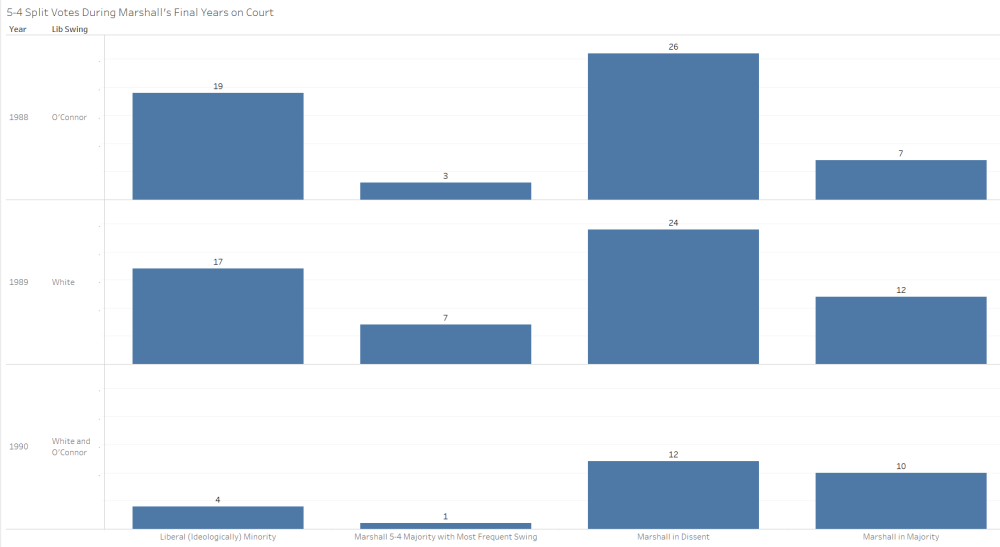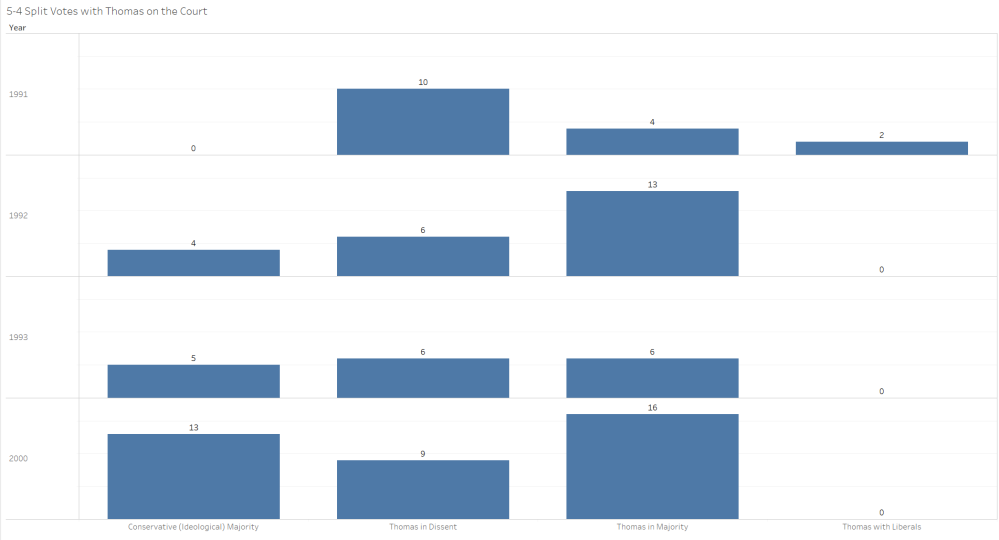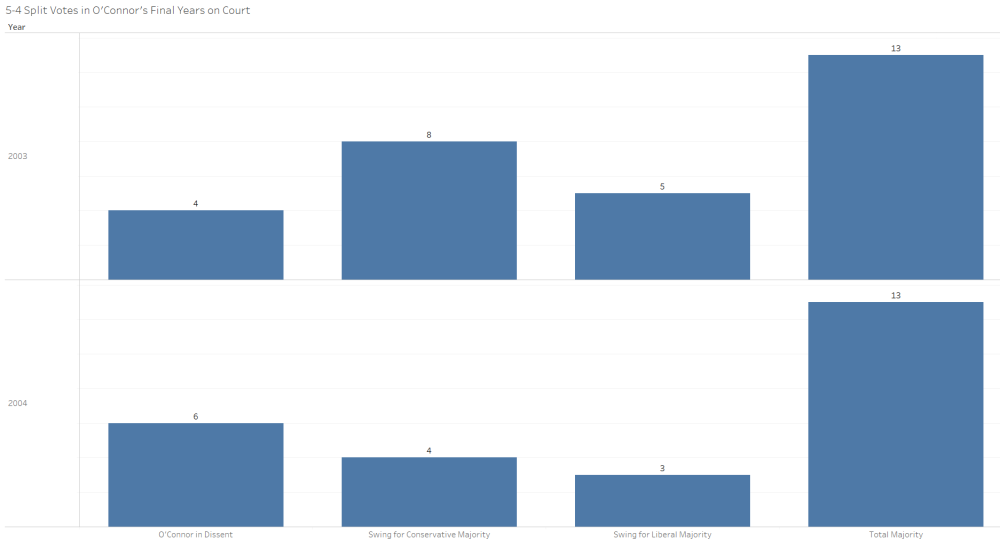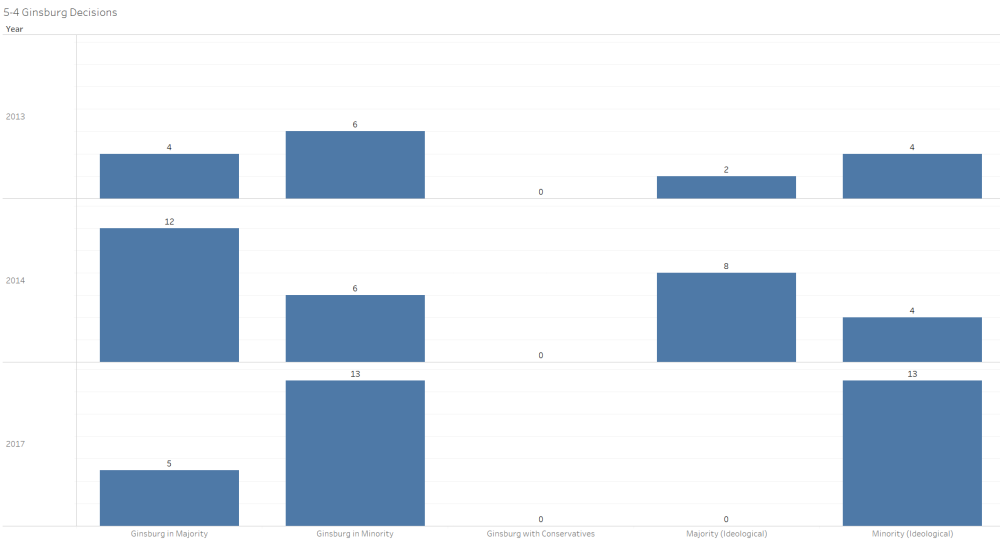The saga over Ruth Bader Ginsburg’s health seems to ebb and flow from the headlines almost daily. Part of the mystery relates to the amount of information shared with the public. We know Ginsburg broke ribs and while providing care for her ribs doctors found malignant lesions in her lungs that were promptly removed. She has since missed oral arguments and is purportedly recovering at home while keeping current with the Court’s business through reading briefs and written transcripts of oral arguments.
At 85 though any major health scare is a concern and she is far from out of the woods yet. Meanwhile news outlets such as Politico have reported that the Trump White House is looking for potential replacements if the justice cannot continue on the Court. Much of the future direction of the Court rests on Ginsburg’s health as a Trump appointment to her seat would almost certainly lead to the most conservative Court in recent memory if not ever.
Members of the public appear aware of the uncertainty surrounding Ginsburg’s health, even with the reassurances that she is cancer free. I recently posted Twitter a poll that asked what will happen to Ginsburg’s seat on the Court depending on Trump’s length of time in office. The poll asked if the respondents thought Trump would remain in office for one or two terms and whether Ginsburg would remain in her seat for the length of Trump’s term(s) of office. While the majority of respondents, 55%, thought Trump will last one term and Ginsburg will remain in her seat throughout the term, a not insignificant minority, 22%, felt Ginsburg would not remain in her seat even if Trump is only a single term president. The other 22% of respondents thought Trump will be reelected to a second term. 19% of this 22% (or 86% of the remaining respondents) thought that Ginsburg would not last through a second Trump term. Only 3% of total voters or 13.6% of the remaining voters thought Ginsburg would retain her seat through a second Trump term.
The results of this poll express a mix of expectations that chiefly appear to depend on whether Trump is reelected. Many political commentators including those on the left were aware of Ginsburg’s potential frailty leading up to the last presidential election and pressed for her to retire in time for Obama to fill her seat with a younger justice. Commentators have followed up on these observations following Ginsburg’s most recent health concerns. Granted, after the Merrick Garland fiasco Ginsburg’s decision does not seem as poorly calculated as it might have otherwise.
Why is this seat more important than Scalia’s or Kennedy’s?
If Trump fills Ginsburg’s seat, it would be the first time this president has the opportunity to shift a seat on the Court from a strong liberal to a staunch conservative. While such a shift has happened before, it is at best debatable whether this has happened on such an already conservative Court. Let’s take a look.
Marshall to Thomas
The only comparable ideological shift occurred when Justice Marshall stepped down from the Court and Justice Thomas was confirmed into his seat. The polarity of difference in these justices’ views cannot be understated. Marshall was a pillar of liberalism in the Warren and Burger Court years while Thomas has been debatably the most conservative justice of this generation. This difference is measurable as well. A justice’s vote can be viewed as most consequential when it shifts the outcome of a decision. We see this in cases decided by one vote, where a shifted vote would switch the outcome from one side to the other.
First a look at these closely decided cases from Marshall’s last years on the Court.
The figure only looks at 5-4 decisions in these three terms. The first column shows the number of 5-4 decisions where the Court’s liberal minority, at that time Marshall, Brennan, Blackmun, and Stevens, formed a bloc in dissent (when Brennan retired in 1990 the 4th most liberal justice on the Court was likely White who was a swing vote for liberals in prior terms). The next column shows the number of times the liberal bloc was in the majority along with the aid of the most common swing vote (the one observation in 1990 involved both White and O’Connor siding with the liberals). The third column shows the number of times Marshall was in dissent in 5-4 decisions in each of these terms and the fourth column shows the number of times Marshall was in the majority in 5-4 decisions in these terms.
Without Brennan the liberal end of the Court was clearly weaker although Souter who joined in 1990 to fill Brennan’s seat later turned out to be a consistent liberal vote. Still, overall Marshall was clearly in the minority in most of these close decisions towards the end of his tenure on the Court. The important counterpoint though is that if Thomas sat in Marshall’s seat in these three terms, many if not most of the 5-4 decisions where Marshall was in the majority would have shifted in the opposite direction.
Some of this becomes evident when we look at comparative statistics for Thomas in 5-4 decisions.
Thomas didn’t come out of the gates with as clear of a conservative predilection as would become evident as he spent more time on the Court. In his first term he didn’t join the more conservative justices in one 5-4 decision, while he sided twice with the four most liberal justices to shift the outcome in their favor in both cases. In his first term Thomas was also in dissent 10 times in 5-4 decisions while only in the majority in four such decisions.
This term marked the last time that Thomas was a swing vote for the Court’s liberals though. In the coming years Thomas would join with Rehnquist, Scalia, Kennedy, and O’Connor to form a strong, although not impenetrable, conservative majority. Thomas was in this ideological majority in 5-4 decisions four times in his second term, five times in his third, and 13 times in the 2000 term. Thomas tended to be in the majority of all 5-4 decisions more times after his first term and was in dissent less frequently.
These votes had more than a theoretical impact on the course of the Court’s jurisprudence late in Marshall’s career. In 1989, Marshall had a key vote in the County of Allegheny v. American Civil Liberties Union decision. Marshall voted alongside Blackmun, Brennan, Stevens, and O’Connor holding that a creche inside a courthouse was an endorsement of Christianity and in violation of the Establishment Clause. In 1987, Marshall was requisite vote for the 5-4 majority in United States v. Paradise that upheld a promotion scheme that required one black employee for every white employee promoted under the Equal Protection clause. Such decisions would most likely have gone in the other direction without Marshall’s vote.
Thomas votes had a substantial impact in close decisions in his first few years on the Court. The Court’s conservative majority (Thomas, Rehnquist, Scalia, White, and Kennedy) in Heller v. Doe (1993) held that under rational basis scrutiny, Kentucky’s procedures for involuntarily committing mentally retarded persons did not violate the Equal Protection clause. That outcome would have likely gone in the opposite direction with Marshall on the Court instead of Thomas.
In Zobrest v. Catalina Foothills School District (1993) a 5-4 conservative majority composed of the same justices held that a school could not deny an interpreter to a deaf child based on the Establishment Clause. Under that ruling the state’s responsibility to provide an interpreter should not hinge on whether a school is religious or secular. Thomas would prove time an again to be an essential conservative component in closely decided cases as the decisions described above only provide some context from Thomas’ first years on the Court
O’Connor to Alito
O’Connor was nowhere near as predictable a liberal vote as was Marshall. To the contrary, O’Connor predominately aligned herself along with the Court’s conservatives, but was more moderate than some of her conservative counterparts. Still, the shift from O’Connor to Alito marked another significant move rightward for the Court.
O’Connor’s importance to both ends of the ideological spectrum is evident from her last two terms on the Court:
During these two terms O’Connor was much more often in the majority in 5-4 decisions than in the Court’s minority. While she acted as the swing vote more often for the conservatives — Scalia, Rehnquist, Thomas, and Kennedy — she was also the swing vote for the liberals — Stevens, Souter, Ginsburg, and Breyer — not an insubstantial number of times.
Without O’Connor’s vote in support of abortion’s legality, for instance, the Court very well may have overturned Roe v. Wade with its decision in Planned Parenthood v. Casey. This was not the only landmark case that O’Connor helped decide with the liberals . In Grutter v. Bollinger, O’Connor wrote the majority opinion that was joined in full by Stevens, Souter, Ginsburg, and Breyer, and which upheld University of Michigan Law School’s use of racial preferences in admissions decisions. O’Connor was also a swing vote for the liberals in McCreary County v. American Civil Liberties Union where the Court held that displays of the Ten Commandments in public schools and courthouses violates the Establishment Clause of the First Amendment.
In contrast to O’Connor’s decisions along with the Court’s liberals, Alito never waffled between ideological poles in close cases.
Alito has still yet to side with the four more liberal justices on the Court in a 5-4 decision. Half or more of his decisions in the 5-4 cases depicted above supported an ideologically conservative majority consisting also of Roberts, Thomas, Kennedy, and either Scalia or Gorsuch. The vast majority of his dissents in 5-4 decisions were with the same grouping aside from Kennedy.
The impact of Alito’s coalitions is substantial as well. Early in his tenure on the Court, Alito sided with the other conservative justices in Kansas v. Marsh upholding Kansas’ death penalty statute that would allow capital punishment in instances with equal mitigating and aggravating factors. Soon thereafter Alito also sided with the conservative majority in Gonzales v. Carhart, where the 5-4 majority upheld the constitutionality of the Partial-Birth Abortion Ban. While only applicable in limited instances, this ruling was seen as a significant step back for pro-abortion advocates.
Ginsburg
Similar to Marshall, Ginsburg has been one of the most consistent liberal votes on the Court for many years. This is apparent in Ginsburg’s votes over the last several terms with a full nine member Court.
In these three terms there were no instances where Ginsburg sided with the more conservative justices — Scalia/Gorsuch, Thomas, Alito, and Roberts — in a 5-4 majority. Ginsburg was, however, in ideologically liberal majorities in many of her 5-4 decisions. The 2017 term was an anomaly for this as Kennedy did not side with the Court’s liberals in a single 5-4 decision. Consequently, every 5-4 decision in 2017 where Ginsburg was in the minority (13 in total) involved a dissenting coalition along with Breyer, Sotomayor, and Kagan.
Had a conservative justice filled Ginsburg’s seat over the past decade, the Court might have gone in an entirely different direction. Some of the biggest liberal victories in cases such as Fisher II (affirmative action), Obergefell v. Hodges (same-sex marriage), Whole Woman’s Health v. Hellerstedt (striking down restrictive abortion laws), and Nat’l Fed. of Ind. Business v. Sebelius (healthcare) would have presumably gone in the other direction without Ginsburg’s vote. Based on this supposition, one can imagine the direction the Court would move if a much more conservative justice fills Ginsburg’s seat.
How Trump Might Fill the Seat
The most talked about candidate that was not nominated to fill Kennedy’s seat was most likely Judge Amy Coney Barrett. Even after Kavanaugh was nominated to the seat, news outlets (e.g. The Daily Beast and Washington Post) pointed out how Trump might have missed the mark with his pick. The time would be right for Trump to look to Barrett to fill Ginsburg’s seat if given the opportunity to do so. In this scenario Trump would have the opportunity to nominate a vocal Christian (Catholic) conservative who has under two years of experience as a federal court judge (on the Seventh Circuit Court of Appeals). With Barrett, Trump would not reduce the number of women on the Court and would have a judge less exposed to many issues (and thus having a less clearly defined stake in them) than recent nominees Gorsuch and Kavanaugh.
This limited judicial record could well work in her favor. She hasn’t sat on many high visibility cases and so it is difficult to jurisprudentially connect her to certain positions on hot-button issues. Even with her somewhat limited experience though she seems to meet the model of a conservative Roberts Court judge with her votes. The figure below shows the types of parties that Barrett has held for in decisions she has authored as well as which issue areas these cases fall under.
Her generally favorable approach to business and to the government is in sync with much of the Roberts Court’s decision-making. Still, a pro-government stance is much more difficult to discern from appeals court decisions as cases at this court level are are often less complex than the ones Supreme Court hears.Suffice it to say though that she her track record has little to no blemishes that would be a cause for alarm for conservative decision makers.
Barrett has also sat on panels with a mix of Seventh Circuit judges and has generally met with little dissent in her authored decisions. The mix of other judges on panels where Barrett was the majority author looks like the following:
While Barrett’s counterparts on the court have mainly signed on to her opinions, two judges dissented in separate immigration decisions she authored and for similar reasons. Judge Ripple dissented in the recent decision, Yafai v. Pompeo and Judge Durkin who was sitting on a panel by designation dissented in last year’s Alvarenga-Flores v. Sessions. In both cases Barrett upheld immigration decisions that kept potential immigrants from the United States.
Barrett also dissented few times so far on the Seventh Circuit. She has only authored one dissent, in Schmidt v. Foster, a Sixth Amendment case dealing with the right to counsel.
Her viewpoint on abortion, however, has been brought into the spotlight both through a case decision and through her own writings. While she is not bound to a position on this issue she has divulged much more on this issue than most previous nominees. Barrett signed onto Judge Easterbrook’s dissent from denial of an en-banc hearing in Planned Parenthood of Indiana and Kentucky, Inc. v. Commissioner of Indiana State Department of Health. The dissent examined two aspects of an abortion law, one of which would have “[made] it illegal to perform an abortion for the purpose of choosing the sex, race, or (dis)abilities of a child.” The main thrust from the dissent has to do with uncertainty as Easterbrook wrote:
“Does the Constitution supply a right to evade regulation by choosing a child’s genetic makeup after conception, aborting any fetus whose genes show a likelihood that the child will be short, or nearsighted, or intellectually average, or lack perfect pitch—or be the “wrong” sex or race? [Planned Parenthood v.] Casey did not address that question.”
Barrett’s pro-life position is made clearer in her own writings. In “Catholic Judges in Capital Cases,” Barrett along with her co-author John Garvey wrote,
“In modern Catholic teaching, capital punishment is often condemned along with other practices whose point is the taking of life abortion, euthanasia, nuclear war, and murder itself.” They went on to say, “But a more precise statement of the church’s teaching requires a few qualifications. The prohibitions against abortion and euthanasia (properly defined) are absolute; those against war and capital punishment are not.”
While Barrett’s writings do not necessitate an outcome in any particular case, they do put her priors on this issue at odds with Ginburg’s. If Barrett were to fill Ginsburg’s seat we would see a very different face of the Court than we do today and one where different preferences and jurisprudential values reign supreme.
We can compare the extent of ideological shifts between Marshall and Thomas, and O’Connor and Alito to get a sense of the magnitude of a potential move from Ginsburg to Barrett. The figure below plots Martin-Quin Ideological Scores, based the justices’ voting alignments, for the five justices just described.
While a shift from Ginsburg to Barrett might not be as significant on a one-to-one level as the move from Marshall to Thomas, the impact on the overall Court could be much greater.
Even with Ginsburg, the Court’s left leaning justices are outnumbered by those on the right. If the Court’s most veteran, leading liberal were to leave the Court and was replaced by Barrett, the trajectory of the Court, both terms in case selection and adjudication, could very well look nothing like what we have seen in the past.
On Twitter: @AdamSFeldman
Leveraging data for attorneys at Optimized Legal








What was the case in ’90 when O’Connor & White joined with the liberals for a majority? I’m struggling to find it… but probably just don’t know what I’m doing. 🙂
LikeLike
The term was 1990. The case was Chambers v. NASCO (https://www.oyez.org/cases/1990/90-256)
LikeLike
Thanks!
LikeLiked by 1 person